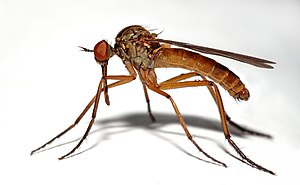Bright dance fly
| Bright dance fly | ||||||||||||
|---|---|---|---|---|---|---|---|---|---|---|---|---|

male |
||||||||||||
| Systematics | ||||||||||||
|
||||||||||||
| Scientific name | ||||||||||||
| Empis livida | ||||||||||||
| Linnaeus , 1758 |
The bright dance fly ( Empis livida ) is a common fly from the dance fly family .
features
Empis livida is generally light brown in color. The legs are light brown, the feet black. The females have a row of flattened bristles on the front of the fore legs and on the rear lower side of the hind legs. The abdomen of the males is mostly quite uniformly light brown, while in the females it has a slightly darker basic color and is grayish pollinated. The abdomen of the males ends in a blunt, rounded genital apparatus, in the females the abdomen tapers to a point. The upper side of the thorax is greyish in color and has three dark longitudinal stripes. The big eyes are reddish brown. In the male they collide on the forehead, in the female they are narrowly separated. The wings of the females are clear, those of the males darkened brown.
distribution
Empis livida is the northernmost species of its subgenus Kritempis . It can be found in Central and Northern Europe. In the north their distribution extends to about 64 ° N, in the south to central France, Switzerland and Austria. The species occurs in Great Britain. In the east, their territory extends through Hungary and Ukraine as far as Russia. The light dance fly likes to live in meadows, pastures and forest edges. They inhabit humid and also rather dry, open plains. Forests and mountains are not very good habitats for this species. It is one of the most common dance flies in Central Europe.
Way of life
The animals fly from May to September. The peak of their occurrence is in early summer. At other times they are usually only found sporadically. They are active all day and like to visit flowers. Aside from nectar, they also have a predatory diet. Especially for mating, the male catches a bride present for the female in the form of another small animal. While the female is busy eating the bride's gift, the male mates with it. The pairs can also fly together, but will usually hang on to a leaf or stalk, with the male holding onto the substrate with his front feet and the female hanging freely. Cannibalism also occurs. This mating behavior is similar to that of many other dance flies. The larvae of the light dance flies probably live predatory in the ground or leaf litter.
literature
- Milan Chvála: The Empidoidea (Diptera) of Fennoscandia and Denmark: Genus Empis. III 1994

